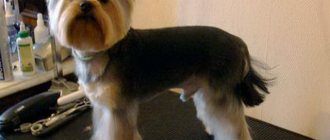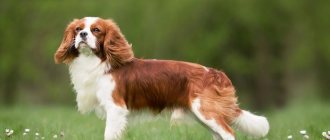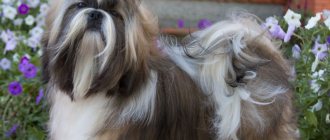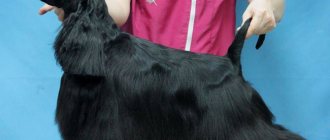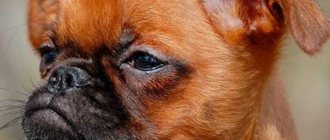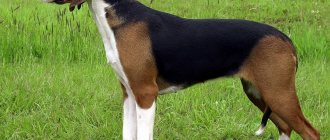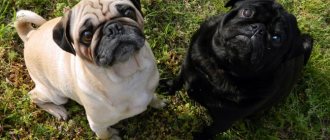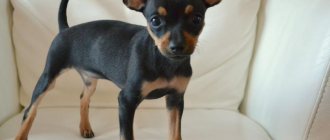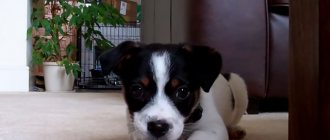The Teddy Roosevelt Terrier is a small hunting dog named after the 26th President of the United States.
The Teddy Roosevelt Terrier is close and similar to the Rat Terrier, another American terrier breed, but with longer legs. Affectionately known as “Teddy,” this terrier is small, feisty, energetic and fun-loving.
Teddy Roosevelt Terriers are friendly and sociable, always ready for fun. They are excellent family dogs and wonderful companions for respectful children who handle them gently.
Due to their small size, these terriers can live well in small houses and apartments as long as they get enough daily exercise in the fresh air.
After a long day of playing and walking, Teddy Roosevelt Terriers enjoy cuddling on the couch. Unlike other terriers, this breed tends to be dog friendly and even gets along with larger breeds.
Some Teddy Roosevelt Terriers can live peacefully with cats if raised together. However, they have a high hunting instinct (to chase and kill small animals), so they should not be left near small domestic animals: rabbits, guinea pigs and hamsters.
Characteristics of the Teddy Roosevelt Terrier
| Attachment level | High |
| Friendliness | High |
| Child friendly | High |
| Loyalty to other pets | Average |
| Exercise Needs | High |
| Playfulness | High |
| Energy level | High |
| Learning ability | High |
| Intelligence | High |
| Tendency to bark | Average |
| Shedding amount | Average |
Feeding
Active and energetic dogs like Teddy the Terrier need to eat a balanced diet. The daily diet may include: boiled meat, fish, porridge from cereals and vegetables, low-fat broth. Vitamins and calcium should be given as supplements to maintain immunity and good physical condition of dogs.
Dry food for small dogs is also suitable as an alternative food option. They already contain the necessary nutrients in the right quantities. Like any dog, terriers love to beg for food from their master's table. But they should not indulge in this. Floury, salty or sweet foods can cause indigestion in your dog.
History of the Teddy Roosevelt Terrier
At one time, the Rat Terrier and the Teddy Roosevelt Terrier were considered two varieties of the Rat Terrier breed. The long-legged variety (the modern Rat Terrier) was known as the Type A Rat Terrier, and the short-legged variety (the modern Teddy Roosevelt Terrier) was known as the Type B Rat Terrier.
Both types of terriers were small, hardy, working terriers who performed the important work of keeping farms and homes free of rats, mice and other vermin.
These terriers evolved randomly, so there are no breeding records to pinpoint the breeds that were involved in their development. However, it is believed that the ancestors of today's Rat Terrier and Teddy Roosevelt Terrier were probably the Smooth Fox Terrier, Manchester Terrier, Bull Terrier, Beagle, Whippet, Italian Greyhound, and White English Terrier (which is now extinct).
In the 1990s, some breed fanciers wanted to separate the Type A and Type B rat terriers. Their efforts led to the development of a separate breed standard for the Teddy Roosevelt Terrier and the creation of a new national club, the Teddy Roosevelt Terrier Club of America.
The club chose the name Teddy Roosevelt Terrier to pay tribute to President Theodore Roosevelt, who owned a small terrier named Skip, who may have been a rat terrier or a rat terrier mix. President Roosevelt praised Skip for ridding the White House of rats and other vermin.
The Roosevelt Teddy Terrier is recognized by the United Kennel Club and is a member of the Terrier Group. This is part of the American Kennel Club class, which allows the dog to compete in sporting events, pending full recognition.
How to choose an American Hairless Terrier puppy
Puppies are born with soft, short fur. After 8-12 weeks the undercoat disappears. In place of the fallen hairs, open hair follicles remain, which can become inflamed, forming pimples. This is normal, but you should pay attention to such redness, as it may turn out to be a skin rash, that is, an allergic reaction.
It is better to adopt a puppy at 1.5-2 months, when the fur has already fallen out. At this time, the results of the William Campbell test will be indicative. You can adopt an adult dog, but only in extreme cases and being sure that the dog is sufficiently socialized.
Externally, the dog must meet breed standards. The head is rounded, but not in the shape of an apple, but pointed towards the nose. The forehead blends smoothly into the muzzle, without a sharp stop. The eyes are slanted and protruding. The nose is solid color or black. No butterfly or dudley noses are allowed. The ears are erect and V-shaped. Hanging or tucked inwards are not allowed. The teeth are white, large, scissor bite, less often straight.
The neck is straight, slightly tapering towards the head. The muscles on the front legs are evenly developed, the elbows are pressed to the body. The hind limbs are muscular, the metatarsals are located perpendicular to the ground. The paws are compact, the middle toes may be slightly longer than the rest. The dewclaws on the hind legs must be removed. Clubfoot and flat paws are unacceptable.
The ribs form a broad chest. On the side of the chest there is a small oval forburst. The line of the back is straight, without drooping towards the hindquarters. The tail is thick, tapering towards the tip. A curled or crooked tail is not acceptable.
If you want to buy an American Hairless Terrier “for the hobby” and not for participation in an exhibition, then you should not be too concerned about meeting all the parameters of the standard. The puppy’s parents may not have high-profile titles; the exterior grade is “good.” A dog with such ancestors will not participate in exhibitions and breeding, but is perfect for keeping in a family.
Caring for a Teddy Roosevelt Terrier
The Teddy Roosevelt Terrier's short, smooth coat sheds moderately, and regular brushing will help keep it to a minimum. Bathe your pet as needed and trim his nails every two weeks.
Check your ears weekly for redness, dirt, or odor. Clean the ears with an ear cleaner and make an appointment with your veterinarian if they appear sore, have excessive discharge, or have a foul odor.
Teddy Roosevelt Terriers are very athletic and full of energy. They need a lot more exercise than you might imagine given their small size.
Daily walks or hikes are good, but you can add swimming, active ball games and training for a canine sport such as agility, flyball, obedience or digging. When you are walking, keep your friend on a leash. The instinct to chase and hunt small animals is so strong that the dog can run out onto the roadway.
Smart, inquisitive and obedient, Teddy Roosevelt Terriers can be taught almost anything. Train him in a fun and positive way, using treats or toy rewards and lots of praise. They love to dig and will happily rid your home and property of rats, mice, gophers, moles and other vermin.
To keep your Roosevelt Terrier from digging in places you don't intend, set up a digging area in certain parts of the yard. You can even use a children's sandbox filled with sand or soil. Secretly bury treasures such as treats, chews, and toys for your terrier to find.
Pros and cons of the American Hairless Terrier breed
Advantages of the breed:
- AHT does not cause allergies, since the particles of the epidermis adhere to the dog’s skin without spreading into the air. Removed mechanically during bathing.
- An affectionate, playful dog is suitable for a family with a child. AGTs quickly calm down after the end of the game, so there is little risk of injury.
- Compact dimensions allow you to keep an adult AGT dog in a regular apartment, without allocating a separate place with a large area.
- The nature of the AGT contributes to its fast and effective training.
Disadvantages of the breed:
- AGT's skin is delicate, like a human's. A dog can get sunburned in direct sunlight and get frostbite in sub-zero temperatures.
- Once a week, the dog’s skin needs to be smeared with cream to prevent it from drying out. In summer, before going for a walk, it is advisable to use sunscreen.
- You should keep hydrogen peroxide in your first aid kit to treat scratches and wounds.
General health problems
Although Teddy Roosevelt Terriers are generally healthy and hardy, like all purebred dogs, they can be predisposed to certain genetic diseases.
Problems that have been identified in this breed include primary lens displacement (a painful eye disease that causes glaucoma), chondrodystrophy (a severe type of disc disease), and patellar luxation (kneecaps that slip out of place). It is recommended that all Teddies undergo appropriate genetic testing, cardiac screening for heart health, and have their joints examined and assessed before breeding.
Similar breeds
Most representatives of the “Terrier” group are similar in habits to dachshunds. The same burrow hunting, agility, loud barking - something that is akin to hunters of foxes, raccoons, and badgers.
They were bred to extract trophies from the ground, but they can follow a blood trail for a long time, catch up, drive. This is similar to pointing breeds.
Large and medium-sized breeds can become service dogs that help in searching and detecting dangerous substances. Some of them are faithful assistants for the rehabilitation of patients. They serve in the police, army, and customs.
In character, some pets are similar to Labradors in their devotion, sincerity, love for family and owner. It is important for them to always be nearby, despite the desire to rush off to play with other dogs. They appreciate care and attention. For their friends, these are very affectionate dogs.
Average representatives of the terrier breeds easily cope with the tasks of guarding and herding livestock. In this they are similar to shepherds, who skillfully herd the herd, protect the flock from attack in time, and do not let strangers in. Therefore they are suitable for agricultural breeds.
By their nature, shorthaired terriers are similar to Molossians. They are distinguished by calmness and leisurely behavior as long as there is no potential victim nearby. This also includes a harsh, brutal exterior that can frighten with its appearance.
How and what to feed
To avoid overfeeding your Teddy Roosevelt Terrier, feed a measured amount of food twice a day. Free-feeding (leaving the bowl constantly full) can lead to weight gain, which can put stress on your joints and back, as well as cause other health problems such as diabetes.
On the other hand, some very active dogs may need more food to fuel their bodies. If you are unsure how much to feed, ask your veterinarian or breeder for advice.
pros
- Great family dog
- Affectionate and attractive
- Friendly to children and dogs
Minuses
- Can dig up the yard
- Needs a lot of exercise
- Strong prey drive/unsafe to let off leash
Appearance
The Teddy Roosevelt Terrier is a short, muscular, active, small to medium sized hunting dog. The preferred ratio of body length to height at the withers is 10:7–10:8. Disproportionality of build is considered a serious drawback, as it leads to a decrease in dexterity and activity.
Regardless of gender, according to the breed description, the Teddy Roosevelt Terrier must have developed, dense and heavy muscles. The height of dogs ranges from 20.3 cm to 38.1 cm. Weight is proportional to body build. At the same time, obese dogs are rejected from breeding work, since the dog has a very active temperament and they are not naturally prone to gaining excess weight.
The Teddy Roosevelt Terrier is an active and alert dog, with an inquisitive mind and highly developed intelligence. They are very flexible in education and training, sociable, proactive and love to spend time with the owner.
The Teddy Roosevelt Terrier is distinguished by its lively character, friendliness, and love for its owner and family members. It is important to understand that the animal has a highly developed guarding skill and is often guided by instincts.
Breed standard
- The head is small, proportional to the dimensions of the body. When viewed from the side, the skull and muzzle are of equal length and are connected by a moderate transition. An abrupt transition is considered a fault. Upon examination, the Teddy Roosevelt Terrier's head has a blunt wedge shape. The skull is wide, voluminous, slightly tapering towards the muzzle. An apple-shaped head is considered a defect. The muzzle is well filled under the eyes, has clean lines and tapers slightly to the nose. The jaws are powerful and deep, allowing the dog to open its mouth to hold prey.
- The teeth are complete, tightly set, strong, white. A scissor bite is preferred, but a straight bite is also acceptable. Absence of teeth (even after removal for medical reasons), overshot and underbite are considered disqualifying defects. The jaws are powerful with well-muscled cheeks. Lips are dry and tight-fitting. The color of the lips matches the pigmentation of the nose.
- The nose is small, mobile, sensitive. Black pigmentation is preferred, but a color harmonizing with the color of the coat is also allowed.
- Eyes – shape varies from round to almond-shaped. The eyes are small, set at a slight angle. The pigmentation of the eyelids corresponds to the nose. Eye color varies from dark brown to amber and is in harmony with the color. Blue or amber eyes are only allowed for blue dogs, but dark gray eyes with blue pigmentation on the eyelids are preferred.
- The ears are V-shaped and open, set on the highest line of the skull. Ear cartilage is thin but elastic. Adult dogs have erect ears. Ears that are not fully raised are considered a fault if the dog has reached one year of age.
- The body is elongated, fit and very muscular. The length of the front legs from the point of the elbow to the ground should be approximately one third of the dog's height. The neck is moderately long, slightly arched, tapering from the shoulders to the head. Regardless of whether the dog is standing or moving, the line of the back should remain straight. The loin is moderately short, slightly arched and muscular. The croup is moderately sloping. The ribs are well drawn back, forming a broad, strong back. The sternum extends to or just below the elbow. From the front, the chest (between the front legs) is well filled on both sides of the keel protruding forward.
- Limbs – shoulders are smooth, inclined, muscular. The front legs are almost vertical from the shoulder blades to the ground. The elbows are placed close to the body. From the front, the forearms rotate slightly inward, so that the distance between the wrists is slightly less than the distance between the elbows. The pasterns are straight, although a slight bend is acceptable. The hind legs are strong and flexible, muscular, with the length of the upper part of the thigh being slightly longer than the lower part. The stifles are well arched and the hocks are strictly parallel. When the dog is standing, the short, strong hind pasterns are perpendicular to the ground and, when viewed from behind, parallel to each other. The brushes are compact, oval in shape. The two middle toes are slightly longer than the other toes. Cat claws are acceptable. Loose paws are allowed. Dewclaws on the front paws are removed at will, but on the hind paws it is mandatory.
- The tail is set at the same level with the slope of the croup. A naturally short tail is preferred, but natural length is not a disadvantage. The tail, down to the hocks, is thick at the base and tapers to the tip. When the dog is excited, the tail is raised up and slightly curved.
Teddy bear boy
The Malshi is a mix between the Maltese and the Shih Tzu.
These teddy bears are small with adorable personalities - they are loving and quick learners, making training easy.
If Malshis are not trained and socialized properly, they may become nervous in new situations, which can lead to excessive barking.
The most common health conditions in Mashis include luxating patella, hip and elbow dysplasia, eye problems and hypothyroidism.
Malshis can live up to 14 years, especially with proper care.
In addition to daily exercise, Malshis should be groomed daily to prevent knots and tangles and keep the coat silky.
Poochon teddy bear
The Poochon is a cross between a Poodle and a Bichon Frize.
These dogs live up to 15 years and are relatively small.
They are easy to train and although they don't shed much, they do require regular grooming.
Pehonians are very intelligent dogs and love companionship - they can suffer from separation anxiety if they are left alone for too long, so not the best choice if you spend a lot of time away from home.
They are also good with older children, although their tendency to be noisy when playing may mean they are not suitable for families with younger children.
Schnoodle Bear Dog
Schnoodles are a cross between a schnauzer and a poodle.
Their size varies depending on the type of poodle you are using - you can get a smaller Schnoodle measuring up to 30cm at the withers, or a larger one by measuring twice that!
Their coat color depends on what they inherit from their parents, as well as the length and curl of their coat!
They usually require a lot of care and attention as they love to be surrounded by their families.
